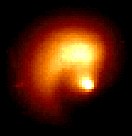The Satellites of Comet Hale-Bopp
A Meta Research Press Release, December 15, 1995
Comet Hale-Bopp was discovered on July 23, 1995. It has the unusual distinction of being bright enough to be seen in amateur telescopes while still farther from the Sun than Jupiter. This may mean that the comet is bigger than most, perhaps even one of the spectacular but rare "great comets", the most recent of which appeared in 1882. But it might just mean that the comet underwent a recent outburst, and will soon fade back to a more typical brightness. As time goes by and the comet shows little sign of rapid fading, hope grows that it is truly a large comet that will become visible to the naked eye in the spring of 1997, when it reaches the inner solar system. If its extrapolated brightness is accurate (always a risky assumption with comets), it might reach about magnitude -2. This is the brightness of the brightest star Sirius. However, a comet's brightness is spread over a far larger angular area, since most reflected light comes from the comet's coma and tail. So the artificial night sky brightness common in cities will prevent viewing the comet except from places where the night sky is reasonably dark.
As readers of the book "Dark Matter, Missing Planets and New Comets" will be aware, author Tom Van Flandern has predicted that both asteroids and comets commonly have satellites. This is a natural consequence of origin of these bodies in the explosive breakup of a larger former solar system planet or moon. But it is almost impossible if comets and asteroids condensed from a primeval solar nebula over 4 billion years ago, as the most popular theory today suggests, because captures are extremely rare events. So when an unusually large comet such as Comet Hale-Bopp is viewed with powerful modern telescopes, either satellites will be present, or they will not; and either way tells us something important about which model of comet origins is more likely to be correct.
The photograph with this article was taken with the Hubble Space Telescope on September 26, 1995, showing the region near the nucleus of the comet in high resolution. The caption supplied with the photo is partially reproduced in smaller typeface near the picture. Clearly, that caption presumes the solar-nebula-origin model, in which orbiting satellites are too improbable to be considered seriously.
The purpose of this press release is threefold:
- To point out that the so-called "blob ejected from the nucleus of the comet" is in all likelihood a satellite of the nucleus in a long-term stable orbit.
- To predict that telescopes will continue to track this same satellite in the same orbit around the comet nucleus all the way into the inner solar system, by which time additional satellites might be seen.
- To call attention to the implications for theories of comet origins this discovery implies.
"HUBBLE SEES MATERIAL EJECTED FROM COMET HALE-BOPP"

(22K) Click here to see full image and press NASA press release.
Credit: H.A. Weaver (Applied Research Corp.), P.D. Feldman (The Johns Hopkins University), and NASA
